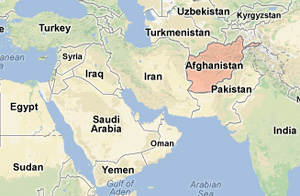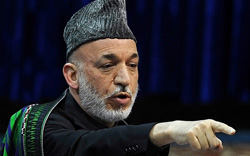U.S. considering ‘zero’ option for Afghanistan in 2014
Daily News Article — Posted on January 10, 2013
Note: This article is from the British newspaper The Daily Telegraph.
(from the Daily Telegraph) – The Obama administration has signaled that it might [withdraw all] troops [from] Afghanistan after December 2014.
The option [is contrary to] the Pentagon’s view that thousands of troops may be needed to keep a lid on al-Qaeda and to strengthen Afghan forces.
“The U.S. does not have an inherent objective of ‘X’ number of troops in Afghanistan,” said Ben Rhodes, a White House deputy national security adviser. “We have an objective of making sure there is no safe haven for al-Qaeda in Afghanistan and making sure that the Afghan government has a security force that is sufficient to ensure the stability of the Afghan government.”
The U.S. now has 66,000 troops in Afghanistan, down from a peak of about 100,000 as recently as 2010. The Obama administration and Nato allies agreed in November 2010 that they would withdraw all their combat troops by the end of 2014, but they have yet to decide what future missions will be necessary and how many troops they would require.
 At stake is the risk of Afghanistan’s collapse and a return to the chaos of the 1990s that enabled the Taliban to seize power and provide a haven for Osama bin Laden’s al-Qaeda network. Fewer than 100 al-Qaeda fighters are believed to remain in Afghanistan, although a larger number are just across the border in Pakistani sanctuaries.
At stake is the risk of Afghanistan’s collapse and a return to the chaos of the 1990s that enabled the Taliban to seize power and provide a haven for Osama bin Laden’s al-Qaeda network. Fewer than 100 al-Qaeda fighters are believed to remain in Afghanistan, although a larger number are just across the border in Pakistani sanctuaries.
Defense Secretary Leon Panetta has said he foresees a need for a US counter-terrorism force in Afghanistan beyond 2014, plus a contingent to train Afghan forces. He is believed to favor an option that would keep about 9,000 troops in the country.
Administration officials in recent days have said they are considering a range of options for a residual U.S. troop presence of as few as 3,000 and as many as 15,000, with the number linked to a specific set of military-related missions like hunting down terrorists.
Asked in a conference call with reporters whether zero was now an option, Mr. Rhodes said, “That would be an option we would consider.”
His statement could be interpreted as part of an administration negotiating strategy. On Friday Afghan President Hamid Karzai is scheduled to meet President Barack Obama at the White House to discuss ways of framing an enduring partnership beyond 2014.
The two are at odds on numerous issues, including a U.S. demand that any American troops who would remain in Afghanistan after the combat mission ends be granted immunity from prosecution under Afghan law. Mr. Karzai has resisted, while emphasizing his need for large-scale US support to maintain an effective security force after 2014.
Information appearing on telegraph.co.uk is the copyright of Telegraph Media Group Limited and must not be reproduced in any medium without license. Reprinted here for educational purposes only. May not be reproduced on other websites without permission from the Telegraph. Visit the website at telegraph.co.uk.
Questions
1. Who is the leader of Afghanistan?
2. How many U.S. troops are currently in Afghanistan?
3. a) In an agreement made in 2010, what did the U.S. and NATO agree do by the end of 2014?
b) What decision hasn't yet been made regarding troops in Afghanistan?
4. a) What is the Obama administration's objective in Afghanistan, according to deputy security adviser Ben Rhodes?
b) Do you think President Obama's policies will achieve this objective? Explain your answer.
5. What is at stake in the decision about how many troops to leave in Afghanistan?
6. What might be the Obama administration's motive for announcing that withdrawing all troops is an option?
7. Should President Obama order all troops to be withdrawn from Afghanistan at the end of 2014, or should he follow Secretary of Defense Leon Panetta's recommendation to leave 9,000 troops in the country to support Afghan troops and continue counterterrorism operations in the region? Ask a parent, and ask him/her to explain his/her answer.
Read this week's "Thursday's Commentary" at: studentnewsdaily.com/commentary/afghan-allies
Background
On negotiations with President Karzai:
- U.S. and Afghan negotiators are working on a long-term deal [for U.S. troop withdrawal]. If talks stall, the U.S. would be compelled to pull all of its troops out of Afghanistan - as it did in 2011 when similar talks with Iraq faltered over a U.S. demand for legal immunity for troops that remained.
- "If there is no authority granted by the sovereign state, then there's not room for a follow-on U.S. military mission," said Douglas Lute, the retired U.S. Army lieutenant general who serves as Mr. Obama's special coordinator on Afghanistan and Pakistan.
- The Pentagon wants to keep at least 9,000 troops in Afghanistan, officials said, to ensure enough forces to support Afghan troops and continue counter-terrorism operations in the region.
- Talk of a smaller U.S. presence has spurred concerns among some Western allies and strategists about whether the remaining forces would be able to prevent another era of instability in Afghanistan.
- The senior NATO official said a force of less than 6,000 would have "very limited" capacity. It would also make it much harder for the Pentagon to convince other allies to send troops as trainers, the NATO official said. (from wsj.com)

